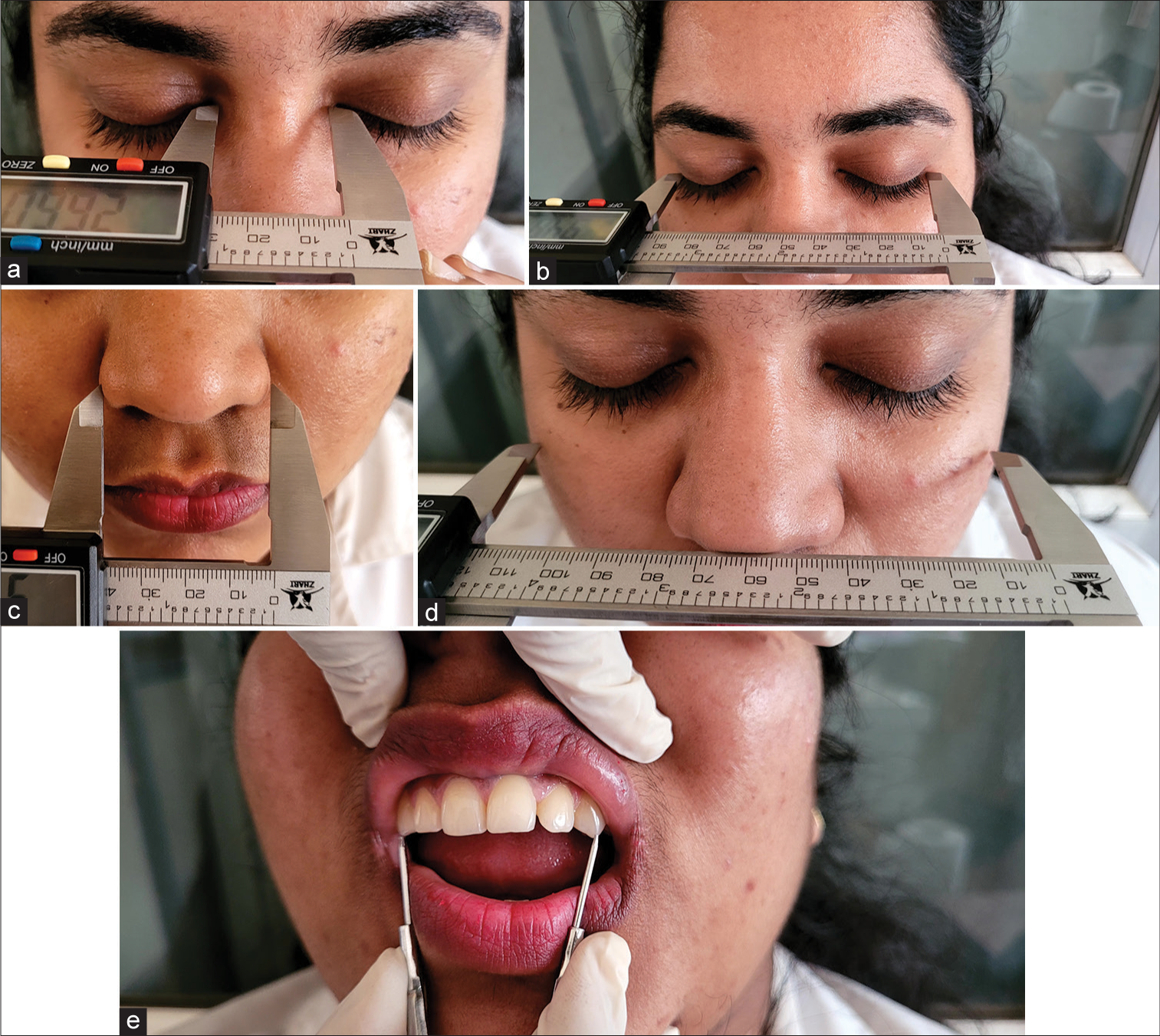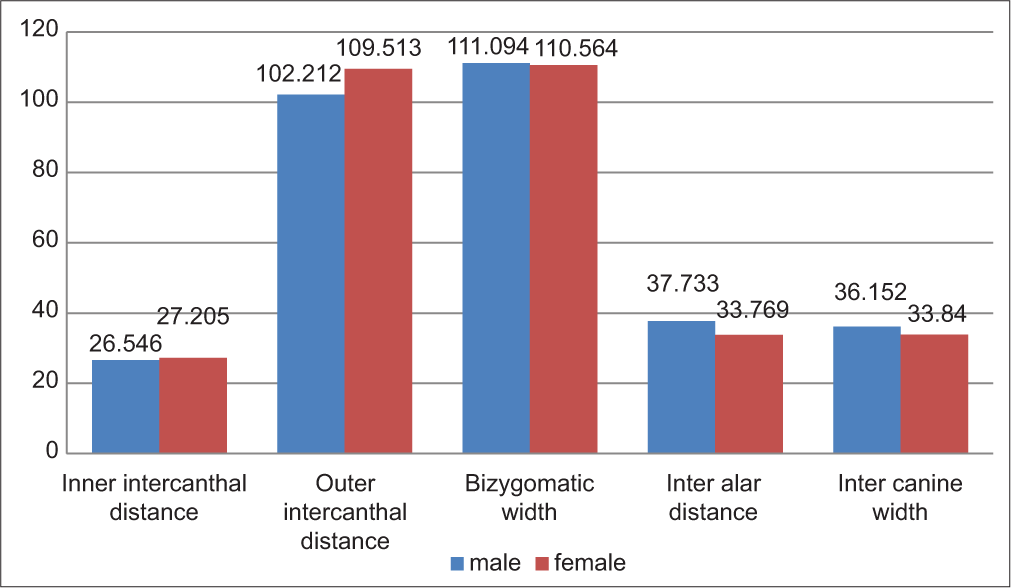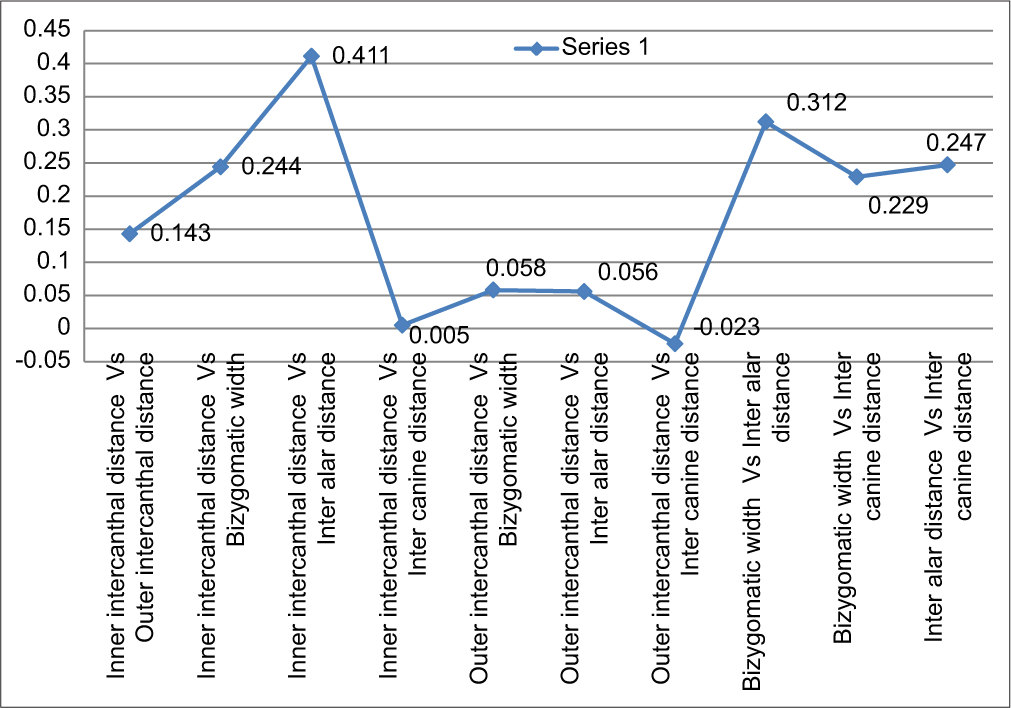Translate this page into:
An anthropometric assessment method for facial profile determination in forensics
*Corresponding author: Uppuganti Devi Naga Sreevalli, Department of Oral Pathology and Microbiology, GITAM Dental College and Hospital, Visakhapatnam, Andhra Pradesh, India. sreevallimds@gmail.com
-
Received: ,
Accepted: ,
How to cite this article: Sreevalli U, Buddha H, Uppala D. An anthropometric assessment method for facial profile determination in forensics. Sri Ramachandra J Health Sci. 2023;3:46-50. doi: 10.25259/SRJHS_28_2023
Abstract
Objectives:
It is extremely difficult for forensic experts to identify the individuals, especially during mass disasters and natural calamities such as earthquakes. In most cases, the facial profile is completely destroyed and the dentition is the only source or tool which helps in identifying the individuals and their gender. The aim of this study was to evaluate and correlate inner intercanthal distance (IICD), outer intercanthal distance (OICD), interalar distance (IAD), and bizygomatic width (BZW) to the maxillary intercanine distance (MICD) to determine facial profile and gender.
Material and Methods:
The study was carried out after informed consent and involved 100 subjects who satisfied the inclusion criteria. Five parameters were measured: IICD, OICD, IAD, BZW, and MICD using digital Vernier caliper. The data were summarized in table form and were statistically analyzed using Pearson correlation.
Results:
OICD was more in females, whereas MICD was more in males. Significant correlation was observed between IICD and BZW (r = 0.224, P = 0.014), IICD and IAD (r = 0.411, P = 0.001), BZW and MICD (r = 0.229, P = 0.022), and IAD and MICD (r = 0.247, P = 0.013); negative correlation was observed between OICD and MICD (r = −0.023, P = 0.818).
Conclusion:
MICD can be used as a tool for the determination of facial profile and gender, although a larger sample size is required for further study.
Keywords
2D facial reconstruction
Maxillary intercanine distance
Inner and outer intercanthal distance
Interalar distance
Bizygomatic width
INTRODUCTION
The human face plays an important role in highlighting human individuality and identity. Human identification becomes complicated, especially when mass disasters take place. In most disasters such as tsunamis, earthquakes, floods, fire accidents, train and road accidents, bomb blasts, and airplane crashes, the fingerprints, facial features, and other pieces of evidence are destroyed, and this makes identification of the individual a complicated procedure. In such circumstances, dental evidence would be a valuable tool of identification since dental structures are the hardest among the body parts and are well preserved in the closed oral cavity. These generally can resist environmental conditions such as fire, decomposition, and desiccation and are among the last ones to disintegrate after death. The basis of dental identification lies in the principal fact that no two oral cavities look alike [1]
Dental features such as the morphology of each tooth, arrangement of teeth in respective arches, shape, and size of teeth, crowding, spacings, rotations, missing teeth, restorations, prosthesis, and other dental anomalies are unique to an individual.[1]
Hence, dental evidence can be used as a tool for the two-dimensional facial reconstruction. The parameters that are necessary for two-dimensional (2D) facial reconstruction are the inner intercanthal distance (IICD), outer intercanthal distance (OICD), interalar distance (IAD), and bizygomatic width (BZW).
The aim of our study was to relate maxillary intercanine distance (MICD) to facial measurements to evaluate its use for the 2D facial construction.
MATERIAL AND METHODS
This study was conducted among the 100 individuals with informed consent. Ethical committee clearance was obtained (EC/NEW/INST/2023/1602). The subjects contain 67 females and 33 males ranging from 18 to 28 years of age group.
These subjects were selected based on the inclusion and exclusion criteria.
Inclusion criteria
The following criteria were as follows: (a) Individuals between 18 and 28 years (b) individuals with the absence of morphological and developmental anomalies, (c) individuals who had complete permanent dentition, and (d) individuals with ideal arch form and alignment.
Exclusion criteria
The following criteria were as follows: (a) Presence of missing teeth, crowding, rotations, spacings, midline diastema, excessive overjet, retained deciduous teeth, and supernumerary teeth in maxillary anterior teeth region, and (b) individuals undergoing orthodontic treatment.
Armamentarium used for the study
Digital Vernier calipers, divider, metal scale, spirit, and cotton [Figure 1].

- (a) Inner intercanthal distance, (b) outer intercanthal distance, (c) interalar distance, (d) bizygomatic width, (e) intermaxillary distance.
Vernier calipers were used for measuring the facial parameters, and a divider with a metal scale was used to measure the MICD. Cotton and spirit were used to sterilize the divider after every use.
Subjects were seated comfortably on a dental chair in a relaxed state and upright position with their head resting against the headrest. They were instructed to close their eyes while measuring the outer and IICD to avoid any injury to the eyes.[2]
All facial parameters were carried out without applying any pressure. IICD was measured from the medial canthus of one eye to the medial canthus of the other eye. OICD was measured from the lateral canthus of one eye to the lateral canthus of the other eye. IAD was determined by measuring the distance between the widest points on the ala of the nose. While measuring, subjects were instructed to stop breathing momentarily, to avoid changes in the shape of the nose. BZW was determined by measuring the distance between the lateral prominences of the zygomatic arch. MICD was determined by measuring the distance between the tips of the maxillary canines [Figure 1a-e].
RESULTS
The mean of different facial parameters, that is, IICD, OICD, IAD, and BZW, MICD in both genders is shown in Table 1 and Graph 1. Most of the facial parameters were comparatively more in males than in females except IICD and OICD [Table 1 and Graph 1].
| Gender | Mean | SD | Mean difference | t-value | P-value | |
|---|---|---|---|---|---|---|
| Inner intercanthal distance | Male | 26.546 | 6.2040 | −0.6590 | −0.606 | 0.546 |
| Female | 27.205 | 4.4957 | ||||
| Outer intercanthal distance | Male | 102.212 | 5.5121 | −7.3013 | −3.89 | 0.698 |
| Female | 109.513 | 107.6136 | ||||
| Bizygomatic width | Male | 111.094 | 17.9862 | 0.5298 | 0.206 | 0.837 |
| Female | 110.564 | 7.7076 | ||||
| Interalar distance | Male | 37.733 | 4.2138 | 3.9647 | 4.958 | 0.001* |
| Female | 33.769 | 3.5190 | ||||
| Intercanine width | Male | 36.152 | 4.0009 | 2.3112 | 3.410 | 0.001* |
| Female | 33.840 | 2.7050 |
Unpaired t-test, *Statistical significance. SD: Standard deviation

- Graphical representation of different facial parameters.
Pearson correlation is depicted in Table 2 and Graph 2. There was a highly significant correlation between the inner intercanthal and BZW (r = 0.224, P = 0.014), IICD and IAD (r = 0.411, P = 0.001), BZW and MICD (r = 0.229, P = 0.022), and IAD and intercanine distance (r = 0.247, P = 0.013). There was a negative correlation between the MICD and the OICD [Table 2 and Graph 2].
| r-value | P-value | |
|---|---|---|
| Inner intercanthal distance versus outer intercanthal distance | 0.143 | 0.157 |
| Inner intercanthal distance versus bizygomatic width | 0.244 | 0.014* |
| Inner intercanthal distance versus interalar distance | 0.411 | 0.001* |
| Inner intercanthal distance versus intercanine distance | 0.005 | 0.962 |
| Outer intercanthal distance versus bizygomatic width | 0.058 | 0.565 |
| Outer intercanthal distance versus interalar distance | 0.056 | 0.578 |
| Outer intercanthal distance versus intercanine distance | −0.023 | 0.818 |
| Bizygomatic width versus interalar distance | 0.312 | 0.002* |
| Bizygomatic width versus intercanine distance | 0.229 | 0.022* |
| Interalar distance versus intercanine distance | 0.247 | 0.013* |
Pearson correlation, *Statistically significant

- Graphical representation of facial parameters using Pearson correlation.
DISCUSSION
This study is based on anthropometric measurements, where facial reference points are related to the maxillary intercanine width for the purpose of human identification. The present study included 100 participants (33 males and 67 females) to assess the relationship between maxillary intercanine width and 2D facial parameters. The respondents were in the age group 18–28 since jaw and facial growth was completed at the end of this period. They were split into two groups male and female, for the current investigation to measure the dimensions of each sex. We aimed to see whether maxillary intercanine width can be used to determine various reference points.[2] We observed substantial correlation between maxillary intercanine width and facial reference points such as IICD, IAD, and BZW; a negative correlation is observed between the maxillary intercanine width and OICD. We also observed that maxillary intercanine width is greater in males when compared to females.
Our study showed a correlation between MICD and other facial parameters, as Shivhare et al. in their study.[2] Meena et al. conducted a study on 85 Aryans and 85 Mongoloids subjects analyzed using Pearson’s correlation which showed a highly significant but weak correlation between MICD and IAD, interpupillary distance(IPD), and intercommissural width (ICOW) in Aryans; a highly significant but weak correlation only between MICD and IPD in Mongoloids.[3] Gomes et al. conducted a study on standard digital images of 81 Brazilian subjects, and Spearman rank correlation was used to show the highest probability of correlation of IICD, IPD, and ICOW with maxillary intercanine width.[4] In the study by Banu et al., it was observed that in females, there is a significant correlation between IAD, IICD, IPD, and MICD.[5] Pisulkar et al., in their study, which was conducted on 200 subjects, MICD and IICD showed a strong positive correlation and IAD and MICD showed a moderately positive correlation.[6] Strajnic et al. conducted a study on 89 subjects, in which it was observed that a moderate correlation was established between the IAD and MICD, and a low correlation was established between the IICD and MICD.[7] Arun Kumar et al. examined 800 subjects and found a consistent ratio of 1.61 between IICD and MICD.[8] Tripathi et al. conducted a study on 500 young individuals and analyzed using Analysis of Variance which showed a highly significant correlation between IAD and MICD.[9] Ahmed et al. conducted a study on 230 subjects and they observed the interpupillary, inner intercanthal, and bizygomatic distance should not be directly used to determine maxillary anterior teeth width, while maxillary anterior teeth width can be determined by modifying the IICD with golden percentage and interpupillary distance with golden proportion.[10]
The soft-tissue thickness was the study’s main flaw. This study was done in an institutional setting, and the evaluation of respondents in the 18–28 age range provides another restriction. As a result, only a tiny population in the relevant age range may find the results useful.[2] IPD and intercommissural distance (ICOW) are not measured, which are also the limitations of the study. Therefore, more research is needed where bony landmarks of large populations can also be used as reference points as this might make the results more accurate.[2]
CONCLUSION
MICD can be used as a tool for the reconstruction of the 2D facial profile and gender determination, although a larger sample size is required for further study.
Ethical approval
The authors declare that they have taken the Institutional Review Board approval and the approval number is EC/ NEW/INST/2023/1602.
Declaration of patient consent
The authors certify that they have obtained all appropriate patient consent.
Conflicts of Interest
There are no conflicts of interest.
Use of artificial intelligence (AI)-assisted technology for manuscript preparation
The authors confirm that there was no use of artificial intelligence (AI)-assisted technology for assisting in the writing or editing of the manuscript and no images were manipulated using AI.
Financial support and sponsorship
Nil.
References
- Dental evidence in forensic identification-an overview, methodology and present status. Open Dent J. 2015;9:250-6.
- [CrossRef] [PubMed] [Google Scholar]
- Intercanine width as a tool in two dimensional reconstruction of face: An aid in forensic dentistry. J Forensic Dent Sci. 2015;7:1-7.
- [CrossRef] [PubMed] [Google Scholar]
- A comparative study to find out the relationship between the inner inter-canthal distance, interpupillary distance, inter-commissural width, inter-alar width, and the width of maxillary anterior teeth in Aryans and Mongoloids. Clin Cosmet Investig Dent. 2016;8:29-34.
- [CrossRef] [PubMed] [Google Scholar]
- Correlation between facial measurements and the mesiodistal width of the maxillary anterior teeth. J Esthet Restor Dent. 2006;18:196-205.
- [CrossRef] [PubMed] [Google Scholar]
- An in vivo study to compare and evaluate the correlation of the facial measurements with the combined mesiodistal width of the maxillary anterior teeth between males and females. J Pharm Bioall Sci. 2017;9:S127-31.
- [CrossRef] [PubMed] [Google Scholar]
- Quantifying the selection of maxillary anterior teeth using extraoral anatomical landmarks. Cureus. 2022;14:e27410.
- [CrossRef] [Google Scholar]
- The significance of biometric parameters in determining anterior teeth width. Mil Med Pharm J Serbia. 2013;70:653-9.
- [CrossRef] [PubMed] [Google Scholar]
- Determination of mesiodistal width of maxillary anterior teeth using inner canthal distance. Med J Armed Forces India. 2015;71:S376-81.
- [CrossRef] [PubMed] [Google Scholar]
- A study to correlate various facial landmarks with intercanine distance. Indian J Dent Res. 2018;29:440-4.
- [CrossRef] [PubMed] [Google Scholar]
- The analysis of facio-dental proportions to determine the width of maxillary anterior teeth: A clinical study. J Clin Med. 2022;11:7340.
- [CrossRef] [PubMed] [Google Scholar]






